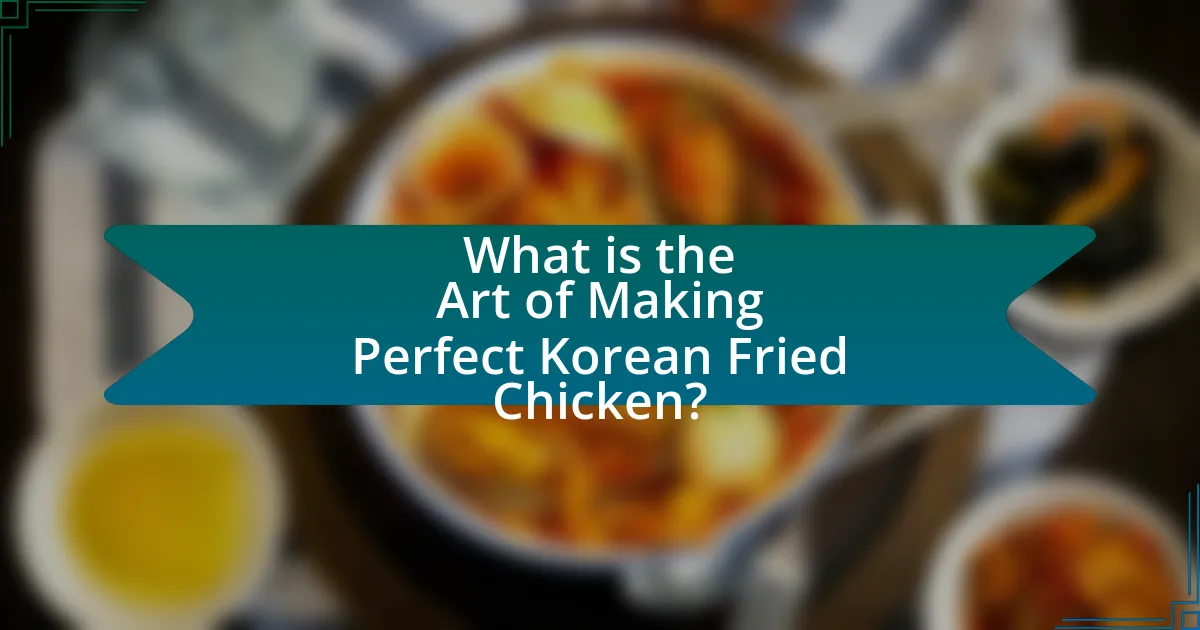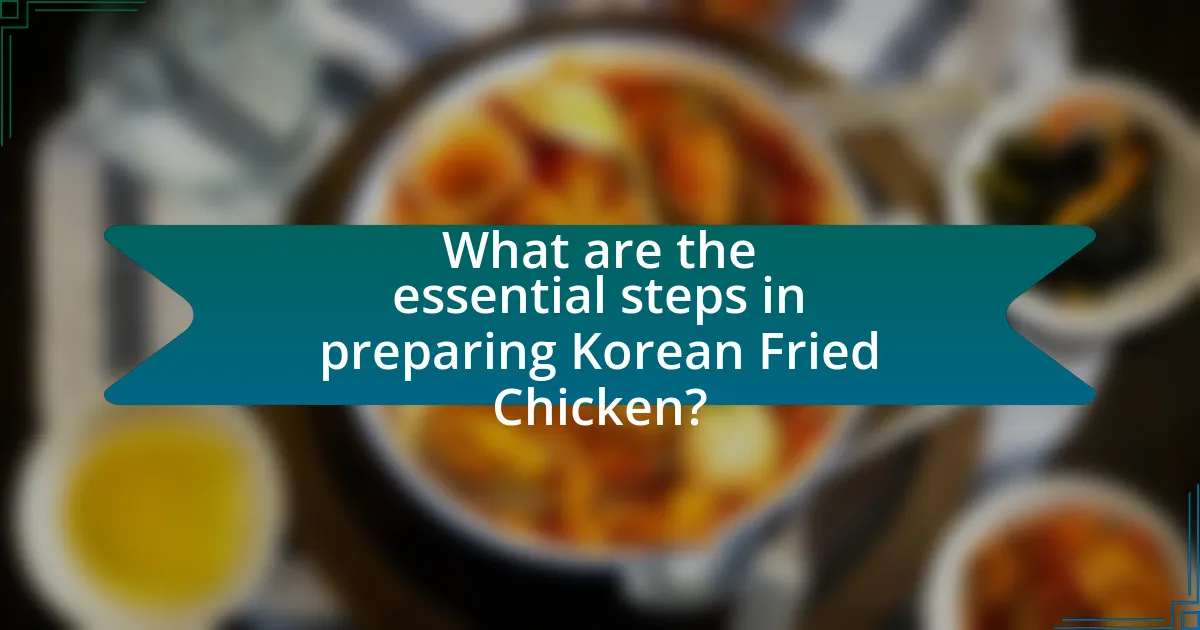The article focuses on the art of making perfect Korean fried chicken, emphasizing the importance of achieving a crispy exterior while maintaining juicy meat through a double-frying technique. Key aspects include the use of a light batter made from flour and cornstarch, marination with soy sauce, garlic, and ginger for flavor enhancement, and the significance of cooking methods such as deep frying and air frying. The article also explores the differences between Korean fried chicken and other fried chicken varieties, the role of spices and marinades, and common mistakes to avoid in the preparation process. Additionally, it discusses popular sauces and toppings that elevate the dish, as well as best practices for serving and storing leftovers.

What is the Art of Making Perfect Korean Fried Chicken?
The art of making perfect Korean fried chicken involves achieving a crispy exterior while maintaining juicy meat inside. This is accomplished through a double-frying technique, where the chicken is first fried at a lower temperature to cook through, then fried again at a higher temperature to create a crunchy texture. The use of a light batter, often made from a mixture of flour and cornstarch, enhances the crispiness. Additionally, marinating the chicken in a mixture of soy sauce, garlic, and ginger prior to frying infuses flavor and tenderizes the meat. The popularity of Korean fried chicken is supported by its unique flavor profile and texture, making it a staple in Korean cuisine.
How does Korean Fried Chicken differ from other types of fried chicken?
Korean Fried Chicken differs from other types of fried chicken primarily in its double-frying technique, which results in an exceptionally crispy exterior while maintaining a juicy interior. This method involves frying the chicken twice at different temperatures, allowing for the removal of moisture and creating a light, airy crust. Additionally, Korean Fried Chicken is often coated in a variety of flavorful sauces, such as sweet and spicy gochujang or soy garlic, which enhances its taste profile compared to the more traditional, often unadorned, fried chicken found in other cuisines. The emphasis on seasoning and sauce in Korean Fried Chicken is supported by its popularity in South Korea, where it is commonly served as a snack or paired with beer, highlighting its unique cultural significance.
What unique cooking techniques are used in Korean Fried Chicken?
Korean Fried Chicken employs unique cooking techniques such as double frying and using a cornstarch batter. Double frying involves frying the chicken twice at different temperatures, which results in an exceptionally crispy exterior while keeping the meat juicy inside. The use of cornstarch in the batter creates a lighter, crunchier texture compared to traditional flour-based batters. This method is supported by the fact that the high starch content in cornstarch absorbs moisture and enhances crispiness, making it a preferred choice in Korean cuisine.
Why is the batter important in Korean Fried Chicken?
The batter is crucial in Korean Fried Chicken because it creates a light, crispy texture that enhances the overall eating experience. This unique batter, often made with a combination of flour, cornstarch, and sometimes rice flour, allows for optimal frying, resulting in a crunchy exterior that contrasts with the juicy meat inside. The use of cold water or ice in the batter helps to create steam during frying, which contributes to the desired crispiness. Additionally, the batter can be flavored with various seasonings, adding depth to the dish.
What are the key ingredients for making Korean Fried Chicken?
The key ingredients for making Korean Fried Chicken include chicken, flour, cornstarch, baking powder, and a marinade typically consisting of soy sauce, garlic, and ginger. Chicken serves as the primary protein, while flour and cornstarch create a crispy coating when fried. Baking powder enhances the texture of the crust. The marinade infuses flavor into the chicken, making it tender and savory. These ingredients collectively contribute to the unique taste and texture that characterize authentic Korean Fried Chicken.
Which types of chicken are best for frying?
The best types of chicken for frying are whole chickens, chicken thighs, and chicken wings. Whole chickens provide a balance of meat and skin, which crisps up nicely during frying. Chicken thighs are favored for their higher fat content, resulting in juicier meat and a crispy exterior. Chicken wings are popular for their tenderness and ability to hold sauces well, making them ideal for various frying techniques. These types are commonly used in Korean fried chicken recipes, which emphasize a crispy texture and flavorful coating.
What role do spices and marinades play in flavoring the chicken?
Spices and marinades are essential in flavoring chicken by infusing it with diverse tastes and enhancing its overall profile. Marinades, which typically contain acidic components like vinegar or citrus, tenderize the chicken while allowing spices to penetrate the meat, resulting in a more flavorful dish. For instance, a marinade with soy sauce, garlic, and ginger not only adds umami but also complements the natural flavors of the chicken. Studies show that marinating chicken for at least 30 minutes can significantly improve flavor absorption, making it juicier and more aromatic. Thus, the combination of spices and marinades is crucial for achieving the desired taste and texture in dishes like Korean fried chicken.
What are the common cooking methods for Korean Fried Chicken?
The common cooking methods for Korean Fried Chicken include deep frying and double frying. Deep frying involves cooking the chicken in hot oil until it is crispy and golden brown, while double frying enhances the texture by frying the chicken twice, resulting in a crunchier exterior. This technique is often used to achieve the signature light and crispy texture that Korean Fried Chicken is known for.
How does double frying enhance the texture of the chicken?
Double frying enhances the texture of chicken by creating a crispier outer layer while maintaining a juicy interior. The first fry cooks the chicken through, allowing moisture to be retained, while the second fry increases the temperature, resulting in a golden-brown, crunchy crust. This method is supported by culinary techniques that emphasize the importance of frying at different temperatures to achieve optimal texture, as seen in traditional Korean fried chicken recipes.
What are the benefits of using an air fryer for Korean Fried Chicken?
Using an air fryer for Korean Fried Chicken offers several benefits, primarily healthier cooking with reduced oil usage. Air fryers circulate hot air, allowing the chicken to achieve a crispy texture similar to traditional frying while using up to 75% less oil, which significantly lowers calorie content. Additionally, air fryers provide quicker cooking times, often reducing the overall preparation time by up to 25%, making it a convenient option for busy cooks. The even heat distribution in air fryers also ensures consistent cooking, minimizing the risk of undercooked or overcooked pieces, which is crucial for achieving the perfect texture and flavor in Korean Fried Chicken.

What are the essential steps in preparing Korean Fried Chicken?
The essential steps in preparing Korean Fried Chicken include marinating the chicken, coating it in a flour mixture, frying it twice, and tossing it in a sauce. First, marinate the chicken in a mixture of soy sauce, garlic, ginger, and other seasonings for at least 30 minutes to enhance flavor. Next, coat the marinated chicken in a blend of flour and cornstarch, which creates a crispy texture. Then, fry the chicken in hot oil at around 350°F (175°C) for the first fry until golden brown, remove it, and let it rest. For the second fry, increase the oil temperature to achieve extra crispiness. Finally, toss the fried chicken in a sauce made from ingredients like gochujang, honey, and sesame oil for added flavor. These steps ensure the chicken is flavorful, crispy, and authentic to Korean cuisine.
How do you properly marinate the chicken for optimal flavor?
To properly marinate chicken for optimal flavor, combine soy sauce, garlic, ginger, sesame oil, and sugar in a bowl, then immerse the chicken in this mixture for at least 30 minutes, preferably up to 24 hours. This method allows the chicken to absorb the flavors deeply, enhancing its taste and tenderness. Research indicates that marinating with acidic ingredients, such as vinegar or citrus, can further tenderize the meat by breaking down proteins, resulting in a juicier final product.
What are the recommended marinating times for different cuts of chicken?
The recommended marinating times for different cuts of chicken are as follows: for whole chicken, 4 to 12 hours; for bone-in pieces, 2 to 6 hours; for boneless pieces, 30 minutes to 2 hours; and for chicken wings, 1 to 2 hours. These times ensure optimal flavor absorption and tenderness. Research indicates that marinating chicken for these durations allows the acids and seasonings to penetrate effectively, enhancing the overall taste and texture of the meat.
How does the marination process affect the final taste?
The marination process significantly enhances the final taste of Korean fried chicken by infusing flavors and tenderizing the meat. During marination, ingredients such as soy sauce, garlic, ginger, and sugar penetrate the chicken, creating a complex flavor profile that balances savory, sweet, and umami notes. Research indicates that marinating can increase moisture retention in the meat, leading to a juicier texture, which is crucial for achieving the desired mouthfeel in fried chicken. Additionally, the acids in marinades can break down proteins, making the chicken more tender, which further contributes to an enjoyable eating experience.
What is the process of coating the chicken before frying?
The process of coating the chicken before frying involves several key steps to ensure a crispy texture. First, the chicken pieces are typically marinated in a mixture of seasonings, which may include soy sauce, garlic, and ginger, to enhance flavor. After marination, the chicken is dredged in a dry mixture, often consisting of flour, cornstarch, and spices, which creates a base layer. Next, the chicken is dipped in a wet batter made from flour and water or egg, allowing for better adhesion of the dry coating. Finally, the chicken is coated again in the dry mixture to achieve a thicker crust. This method is supported by culinary practices that emphasize the importance of a double coating for optimal crispiness, commonly seen in traditional Korean fried chicken recipes.
What types of flour are best for the batter?
The best types of flour for the batter in Korean fried chicken are all-purpose flour and rice flour. All-purpose flour provides a good balance of structure and crispiness, while rice flour contributes to a lighter, crunchier texture due to its lower gluten content. Research indicates that using a combination of these flours can enhance the overall crispiness and flavor of the batter, making it ideal for achieving the signature texture of Korean fried chicken.
How can you achieve the perfect crispy texture in the coating?
To achieve the perfect crispy texture in the coating of Korean fried chicken, use a combination of cornstarch and flour in the batter. This mixture creates a light, airy coating that crisps up well during frying. The cornstarch absorbs moisture and helps to form a crunchy exterior, while the flour provides structure. Additionally, double frying the chicken at different temperatures enhances the crispiness; the first fry cooks the chicken through, while the second fry at a higher temperature creates a golden, crispy finish. This method is supported by culinary techniques that emphasize the importance of moisture control and frying temperature in achieving optimal texture.
How do you ensure the chicken is cooked perfectly?
To ensure the chicken is cooked perfectly, use a meat thermometer to check that the internal temperature reaches 165°F (75°C). This temperature guarantees that harmful bacteria are eliminated while keeping the meat juicy. Additionally, marinating the chicken for at least 30 minutes enhances flavor and moisture retention, contributing to a better texture. Cooking the chicken in hot oil at around 350°F (175°C) for the appropriate time, typically 8-12 minutes depending on the size of the pieces, also ensures a crispy exterior while maintaining a tender interior.
What internal temperature should the chicken reach for safety?
The chicken should reach an internal temperature of 165 degrees Fahrenheit for safety. This temperature ensures that harmful bacteria, such as Salmonella and Campylobacter, are effectively killed, reducing the risk of foodborne illness. The U.S. Department of Agriculture (USDA) recommends this temperature as the minimum safe cooking temperature for poultry.
How can you tell when the chicken is done frying?
The chicken is done frying when it reaches an internal temperature of 165°F (74°C) and has a golden-brown color on the outside. This temperature ensures that harmful bacteria are killed, making the chicken safe to eat. Additionally, the exterior should be crispy, which is a characteristic of properly fried chicken. Using a meat thermometer is the most accurate method to check the internal temperature, confirming that the chicken is fully cooked.

What are the popular sauces and toppings for Korean Fried Chicken?
The popular sauces and toppings for Korean Fried Chicken include gochujang (Korean chili paste), soy garlic sauce, sweet and spicy sauce, and honey butter. Gochujang provides a spicy and savory flavor, while soy garlic sauce adds a rich umami taste. Sweet and spicy sauce combines sweetness with heat, and honey butter offers a unique sweet and creamy topping. These sauces enhance the flavor profile of the chicken, making it a beloved dish in Korean cuisine.
What are the most common sauces used in Korean Fried Chicken?
The most common sauces used in Korean Fried Chicken are gochujang sauce, soy garlic sauce, and sweet and spicy sauce. Gochujang sauce, made from fermented red chili paste, provides a spicy and slightly sweet flavor, while soy garlic sauce combines soy sauce with garlic for a savory taste. Sweet and spicy sauce, often a blend of sugar, gochujang, and other ingredients, delivers a balanced flavor profile that enhances the crispy chicken. These sauces are integral to the dish, contributing to its popularity and distinctive taste in Korean cuisine.
How do different sauces affect the overall flavor profile?
Different sauces significantly influence the overall flavor profile of Korean fried chicken by adding distinct tastes, textures, and aromas. For instance, a sweet and spicy gochujang sauce enhances the dish with umami and heat, while a soy garlic sauce contributes savory depth and aromatic notes. Additionally, a tangy vinegar-based sauce can introduce acidity, balancing the richness of the fried chicken. The combination of these sauces can create a complex flavor experience, as evidenced by the popularity of various regional styles in Korean cuisine, where sauces are tailored to complement the specific preparation methods and ingredients used.
What are some unique toppings that enhance the dish?
Unique toppings that enhance Korean fried chicken include pickled radish, sesame seeds, and scallions. Pickled radish adds a refreshing crunch and balances the richness of the fried chicken, while sesame seeds provide a nutty flavor and visual appeal. Scallions contribute a mild onion taste that complements the dish’s savory elements. These toppings not only elevate the flavor profile but also enhance the overall presentation, making the dish more appealing.
How can you customize Korean Fried Chicken to suit different tastes?
You can customize Korean Fried Chicken to suit different tastes by varying the seasoning, sauce, and cooking method. For instance, you can adjust the spice level by incorporating ingredients like gochujang for heat or honey for sweetness. Additionally, you can experiment with different sauces such as soy garlic, spicy sesame, or even a tangy citrus glaze to cater to diverse flavor preferences. Cooking methods can also be altered; for a healthier option, you might choose to bake or air-fry the chicken instead of deep-frying, which can appeal to those seeking lower-fat alternatives. These variations allow for a tailored experience that can satisfy a wide range of palates.
What variations exist for spicy and non-spicy options?
Spicy and non-spicy variations of Korean fried chicken include different sauces and seasonings that cater to varying taste preferences. For spicy options, popular variations include gochujang (Korean chili paste) sauce, which provides a rich, fermented heat, and a spicy garlic soy sauce that combines heat with umami flavors. Non-spicy variations often feature a soy garlic sauce, which emphasizes savory notes without heat, or a honey butter glaze that adds sweetness and richness. These variations are widely recognized in Korean cuisine, with gochujang being a staple ingredient in many spicy dishes, while soy sauce is a fundamental component in non-spicy preparations.
How can you incorporate local ingredients for a fusion twist?
Incorporating local ingredients for a fusion twist in Korean fried chicken can be achieved by substituting traditional components with region-specific alternatives. For example, using locally sourced spices or sauces, such as a regional hot sauce or herb blend, can enhance the flavor profile while maintaining the essence of Korean cuisine. Additionally, integrating local vegetables, like seasonal greens or root vegetables, into the batter or as a garnish can provide a unique texture and taste. This approach not only supports local agriculture but also creates a distinctive culinary experience that reflects the local culture.
What are some tips for serving and enjoying Korean Fried Chicken?
To serve and enjoy Korean Fried Chicken, it is essential to pair it with traditional sides like pickled radish and a cold beverage, such as beer or soju, to enhance the flavor experience. Serving the chicken hot and crispy is crucial, as the texture is a key aspect of its appeal; the ideal serving temperature is around 160°F (71°C) to maintain its crunchiness. Additionally, offering a variety of sauces, such as sweet and spicy gochujang or soy garlic, allows for customization and enhances the overall enjoyment. These practices are rooted in Korean dining culture, where the combination of flavors and textures is celebrated, making the meal more enjoyable and authentic.
What side dishes pair well with Korean Fried Chicken?
Korean Fried Chicken pairs well with several side dishes, including pickled radish, coleslaw, and steamed rice. Pickled radish, known as “chikin-mu,” provides a refreshing contrast to the rich flavors of the chicken, enhancing the overall dining experience. Coleslaw adds a crunchy texture and balances the dish’s heaviness with its creamy dressing. Steamed rice serves as a neutral base that complements the spicy and savory notes of the fried chicken, making it a staple accompaniment in Korean cuisine.
How should you store leftovers to maintain quality?
To maintain the quality of leftovers, store them in airtight containers to prevent moisture loss and contamination. Properly sealing leftovers minimizes exposure to air, which can lead to spoilage and loss of flavor. Additionally, refrigerate leftovers within two hours of cooking to inhibit bacterial growth, as food left at room temperature for extended periods can become unsafe to eat. According to the USDA, food should be consumed within three to four days when stored in the refrigerator to ensure safety and quality.
What are the common mistakes to avoid when making Korean Fried Chicken?
Common mistakes to avoid when making Korean Fried Chicken include not double frying the chicken, which is essential for achieving the desired crispiness. Failing to marinate the chicken adequately can result in a lack of flavor, as marination enhances the taste and tenderness. Additionally, using the wrong type of flour can lead to suboptimal texture; a combination of all-purpose flour and cornstarch is recommended for the best results. Lastly, overcrowding the frying pan can lower the oil temperature, causing the chicken to become greasy instead of crispy. These practices are crucial for replicating the authentic texture and flavor of Korean Fried Chicken.
How can improper frying techniques affect the outcome?
Improper frying techniques can lead to undesirable outcomes such as soggy texture, uneven cooking, and excessive oil absorption. For instance, frying at too low a temperature can cause the chicken to absorb more oil, resulting in a greasy product, while frying at too high a temperature can burn the exterior before the interior is fully cooked. Research indicates that maintaining an oil temperature between 350°F and 375°F is crucial for achieving a crispy texture and even cooking, as this range allows for proper moisture evaporation and crust formation. Therefore, adherence to correct frying techniques is essential for optimal results in Korean fried chicken preparation.
What are the pitfalls in seasoning and marinating?
The pitfalls in seasoning and marinating include over-salting, insufficient marination time, and using incompatible flavors. Over-salting can lead to an overly salty dish, which masks the natural flavors of the chicken. Insufficient marination time may result in the chicken not absorbing enough flavor, leading to blandness. Additionally, using incompatible flavors can create an unbalanced taste profile, detracting from the intended culinary experience. These pitfalls can significantly affect the overall quality and enjoyment of Korean fried chicken.
What are the best practices for achieving perfect Korean Fried Chicken every time?
To achieve perfect Korean Fried Chicken every time, it is essential to use a double-frying technique. This method involves frying the chicken once at a lower temperature to cook it through, followed by a second fry at a higher temperature to achieve a crispy exterior. The first fry should be done at around 160°C (320°F) for about 10-12 minutes, while the second fry should be at 190°C (375°F) for 3-5 minutes. Additionally, marinating the chicken in a mixture of soy sauce, garlic, and ginger for at least 30 minutes enhances flavor and tenderness. Using a cornstarch and flour mixture in a 1:1 ratio for the coating contributes to the signature crunch. Finally, allowing the fried chicken to rest on a wire rack instead of paper towels prevents sogginess, ensuring the skin remains crispy.


